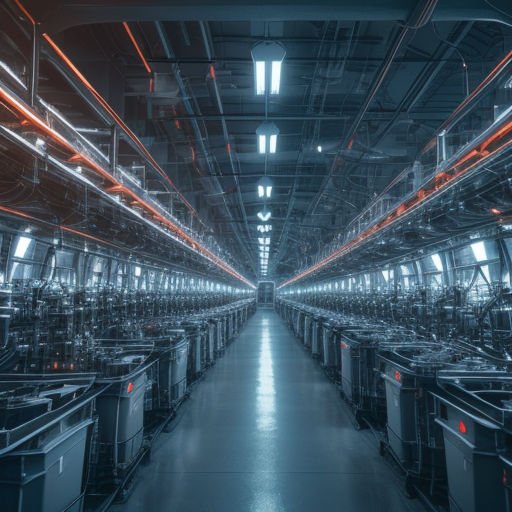Why Your Factory Wants Industrial IoT More Than You Think
Unlocking Efficiency: The Core Appeal of Industrial IoT for Factories
Industrial IoT (Internet of Things) is rapidly transforming manufacturing plants across the globe, reshaping traditional operations into smart, data-driven ecosystems. While some may perceive this technology as just a trend or supplementary tool, the reality is that factories stand to gain immense value from embracing industrial IoT solutions. From reducing downtime to increasing productivity, the integration of connected devices and intelligent data analytics is no longer a luxury but an essential driver of modern manufacturing success.
Understanding why your factory wants industrial IoT more than you might expect begins with examining how these technologies streamline processes and deliver practical benefits that directly impact the bottom line. Let’s explore how industrial IoT is changing the manufacturing landscape and why early adoption can provide a competitive edge.
Driving Predictive Maintenance and Reducing Downtime
Factories often face costly downtime when machines fail unexpectedly, disrupting production schedules and inflating maintenance expenses. Industrial IoT plays a pivotal role in tackling this challenge by enabling predictive maintenance strategies.
Real-Time Monitoring for Early Fault Detection
Industrial IoT networks connect sensors to critical machinery to continuously monitor equipment conditions such as temperature, pressure, vibration, and more. These sensors send real-time data to centralized systems where advanced analytics identify anomalies before they escalate into failures.
– Sensors detect unusual vibration patterns indicating bearing wear.
– Temperature sensors monitor overheating in motors.
– Pressure fluctuations reveal issues in hydraulic systems.
By capturing this data, factories can schedule maintenance only when truly needed, rather than relying on preset intervals. This approach drastically cuts unplanned downtime and reduces maintenance costs.
Case Study: General Electric’s Digital Transformation
General Electric (GE) successfully implemented industrial IoT solutions across its manufacturing operations. Using predictive analytics, GE reported a 10% increase in equipment uptime and a 20% reduction in maintenance costs. This example demonstrates how industrial IoT’s ability to forecast failures before they occur drives operational efficiency and cost savings.
Enhancing Operational Visibility and Decision-Making
One of the most compelling reasons your factory wants industrial IoT lies in improved transparency throughout the production lifecycle. Manufacturers gain comprehensive visibility into every stage of operation, enabling smarter and faster decisions.
Centralized Data Aggregation
Industrial IoT creates an interconnected network where data from machines, processes, and environmental conditions are aggregated into a unified platform. This integration supports:
– Real-time dashboards for production status.
– Alerts for process deviations.
– Historical data analysis for trend prediction.
Managers can monitor factory performance remotely and address bottlenecks or quality issues as they arise, reducing lag between problem detection and resolution.
Boosting Productivity with Actionable Insights
Access to rich, contextual data allows factories to optimize resource allocation, streamline workflows, and anticipate demand shifts. For example, analysis might reveal:
– Inefficient machine idle periods.
– Underutilized labor during shift changes.
– Patterns correlating material quality with defect rates.
Addressing such insights improves throughput and product quality while minimizing waste. As noted in an article by McKinsey, industrial IoT’s data-driven approach can boost manufacturing productivity by 20-30%.
Improving Safety and Compliance Through Connectivity
Industrial environments often involve hazardous conditions and strict regulatory standards. Industrial IoT’s sensor networks and automated monitoring systems significantly enhance workplace safety and compliance adherence.
Real-Time Hazard Detection
IoT sensors can detect gas leaks, excessive noise levels, or unsafe temperature spikes in real time, immediately alerting personnel to potential dangers. This proactive hazard management reduces accidents and protects employee well-being.
Automated Compliance Reporting
Regulatory compliance demands time-consuming documentation and audits. Industrial IoT systems can automatically track and record relevant data such as emissions, operational parameters, and inspection records, simplifying compliance verification and minimizing human error.
Leveraging Industrial IoT for Energy Efficiency
Energy consumption represents a significant cost in factory operations. Industrial IoT helps optimize energy usage and reduce environmental impact while cutting expenses.
Smart Energy Monitoring Systems
By connecting energy meters and sensors to the IoT network, factories gain granular visibility into power consumption across machines, production lines, and facilities. Data analytics identify:
– Peak energy usage times.
– Inefficient equipment consuming excess power.
– Opportunities for load balancing or process scheduling to reduce strain.
Case in Point: Siemens and Energy Optimization
Siemens integrates industrial IoT technology to monitor and control energy systems in their factories. Their approach led to a 15% reduction in energy consumption and a significant decrease in carbon footprint, showcasing how industrial IoT drives sustainable manufacturing practices.
Scaling Innovation and Flexibility in Production
Factories today must rapidly adapt to market changes, customize products, and scale production efficiently. Industrial IoT supports these demands by enabling agile, flexible manufacturing environments.
Connected Robotics and Automation
Industrial IoT facilitates seamless communication between robots, machines, and control systems. This connectivity allows for:
– Faster reconfiguration of assembly lines.
– Adaptive manufacturing based on real-time order changes.
– Collaborative robots (cobots) that safely work alongside human operators.
Supply Chain Integration
IoT extends beyond factory walls by connecting suppliers, logistics, and distributors. This visibility supports just-in-time inventory management and reduces delays or shortages.
Taking the First Steps Toward Industrial IoT Adoption
Recognizing the strong case for industrial IoT, smart factories know the journey begins with strategic planning and incremental implementation.
Assessing Your Factory’s Readiness
Evaluate current infrastructure, machinery compatibility, and existing data processes. Identify specific pain points such as frequent downtime or energy wastage where industrial IoT can deliver immediate value.
Choosing the Right Solutions and Partners
Work with experienced IoT vendors and system integrators who understand manufacturing challenges. Opt for scalable platforms that allow your factory to expand capabilities over time.
– Start with pilot projects focused on high-impact areas.
– Train staff to leverage new data insights effectively.
– Maintain cybersecurity best practices to protect connected devices.
The Role of Open Standards and Interoperability
Adopting industrial IoT solutions built on open standards enables seamless integration across diverse equipment and future-proofs investments. Factories benefit from flexible choice in technology solutions and easier upgrades.
Making Industrial IoT Work for Your Factory
The reality is clear: industrial IoT is not just an optional upgrade but a critical component for factories aiming to thrive in today’s competitive landscape. By harnessing real-time data, predictive analytics, improved safety measures, and energy management, your factory can become more efficient, responsive, and sustainable.
Start by identifying the key operational challenges industrial IoT can solve in your environment. Then, develop a strategic, stepwise adoption plan involving technology partners, workforce training, and robust cybersecurity frameworks. The journey may require investment, but the payoff is a smarter, more agile factory where downtime shrinks and productivity soars.
Embark on this transformation now to secure your place at the forefront of manufacturing innovation. Explore trusted industrial IoT solutions, connect with industry experts, and discover how to unlock maximum value from the connected factory of the future.
For more insights on industrial IoT trends and best practices, visit the Industrial Internet Consortium at https://www.iiconsortium.org/.














Post Comment